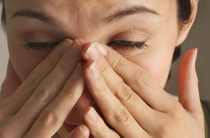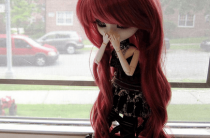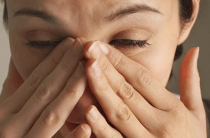Flower allergy is an allergic disease that begins in response to the penetration of plant pollen. The body of some people reacts extremely sharply to the ingress of plant flowering, as a result of which the patient may feel signs of allergies from mid-spring to late autumn. It is extremely difficult to hide from plant pollen at the time of flowering of the allergen plant, it is present not only in the air, but also easily penetrates into all kinds of rooms.
Plant pollen is an extremely fine substance that enters the patient's body in various ways. This may be the lungs, nose, mucous membranes of the eyes, oral cavity or gastrointestinal tract. With an allergy to flowering, several moments of exacerbation of the disease are distinguished, which are associated with the flowering time of certain plants. From April to May, pollination of trees occurs (alder, maple, poplar, oak, birch), from May to July, cereal crops (rye, barley, buckwheat, wheat) bloom, and from August to mid-autumn, weeds are pollinated. The time of their flowering may vary, depending on the specific climatic zone in which the patient lives. You can find out this time using special calendars for allergy sufferers.
The appearance of signs of allergy when plant pollen enters is a consequence of the special sensitivity of the patient's immune system to the protein components present in it. When these components are ingested, the body recognizes them and produces antibodies that serve as signal molecules to trigger allergic reactions. Signs such as inflammation of the mucous membrane or vasodilation that the patient notices before the eyes or in the nose are nothing more than an attempt by the body to send immune cells to fight the harmful substance.
Pollen that causes allergy symptoms has the following properties:
- It should be very light, which ensures its transfer over long distances;
- The content of a significant concentration of allergenic components that are of protein origin;
- The size of the pollen must be microscopic. Large pollen does not penetrate the mucous membranes well, therefore it does not excite allergy symptoms.
In addition, signs of an allergy to flowering are directly related to the environmental situation. The more unfavorable it is for a person, the more often episodes of allergic reactions are observed in these areas, and they proceed with greater intensity.
Signs of pollen allergy
Signs of allergy to flowering, for the most part, are represented by allergic reactions from the organs of vision, nose, bronchi, larynx and lungs. Isolated forms that occur only with damage to one organ are very rare. The most common clinical picture in this disease is allergic-inflammatory reactions that occur in the eyes and nose, occurring along with lesions of the throat.
The first signs that plant pollen is an allergen for the patient are sneezing, sore throat, various unpleasant sensations in the throat, tearing, burning and itching in the eyes. Somewhat later, there are other signs of an allergic reaction, the occurrence of which takes more time. These include: redness of the eyes, nasal congestion, heavy breathing. There is also an allergic rhinitis, which passes with copious discharge. A rather unpleasant accompaniment to a runny nose is pain in the forehead, which is often found with an allergy to flowering. You may also experience earache and headache, which is similar to a common migraine.
Allergy symptoms disappear over time, after the allergen plant has faded, or the patient has managed to successfully protect himself from the flowering of a harmful plant. It is impossible to say exactly when this will happen, since much here is determined by the innate characteristics of the patient's immune system. But as the plant pollen disappears, most patients experience relief on the third day.
How intensely the signs of the disease will appear is associated, in addition to individual characteristics, with such factors as the concentration of plant flowering, the time period of contact with pollen, environmental pollution and the presence of concomitant diseases.
Signs of general malaise with an allergy to flowering
In addition to the specific signs that are characteristic of an allergy to flowering, general symptoms may also be present, indicating the development of a malaise. These include a sharp increase in body temperature, which indicates the active work of the immune system to combat harmful agents. This is accompanied by chills. Chills are a specific feeling of being cold despite the warmth in the room, which is caused by a change in blood circulation due to temperature.
Also, pollen often enters the gastrointestinal system, which is caused by its small size. In this case, after a few hours, a feeling of nausea may be added to the main symptom of allergy, which can subsequently lead to vomiting. There may be pain in the lower abdomen, impaired stool, bloating, frequent belching. These signs indicate the intense effect that plant pollen has on the mucous surface of the gastrointestinal tract.
Bronchial asthma
Bronchial asthma may be a sign of an allergy to flowering. In this case, its symptoms come to light along with the penetration of plant flowering by inhalation. The disease is an acute reaction of the respiratory system in response to contact with an allergen. This manifests itself as a sharp suffocation that occurs as a result of contraction of the muscles surrounding the bronchi, as well as an intense accumulation of sputum in the respiratory tract. Asthmatic attacks pass with sharp cough and intense pressure in the chest.
A sign that bronchial asthma of an allergic nature is the development of its symptoms immediately, with the onset of the allergen. While in other periods of the year, the disease acquires the character of remission. In addition to the actual asthmatic picture of symptoms, inflammation of the nasal mucosa, gastrointestinal ailments, and other symptoms of pollen allergy may be present.
By themselves, they do not provoke bronchial asthma in case of allergies, but during attacks they stimulate their exacerbation, which also adversely affects the general symptoms.
What to do if you experience signs of a pollen allergy?
- Don't self-diagnose or prescribe medication. With allergies, they can cause serious adverse reactions if applied incorrectly. First of all, make an appointment with an allergist;
- Check the flowering calendar in your area (located at the nearest clinic) in order to take appropriate measures in time;
- When a harmful plant blooms, try to leave its habitat. This is the most reliable way to protect yourself from his influence;
- You should not walk, with low humidity, during the wind, as well as in the morning and afternoon hours. Under such conditions, pollen in the air is in the greatest quantity and penetrates much more intensively through the eyes and respiratory system;
- Windows must be equipped with special nets that have a minimum width of gaps;
- In your home, do wet cleaning more often and get rid of fabric curtains, soft toys and other decorative items. After all, the dust that accumulates on them contains a large amount of pollen;
- After a walk, send clothes to the wash, wash yourself thoroughly, rinse your hair;
- Devices that purify the air in the room will help you to minimize the amount of pollen in the house.
And of course, the most important and effective method is to follow the treatment prescribed by a specialist, which will help you get rid of the signs of allergies and survive the flowering period with minimal harm to health and physical discomfort.










